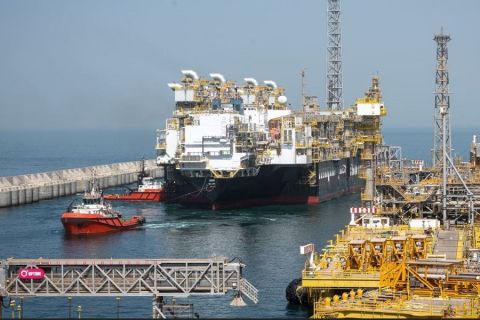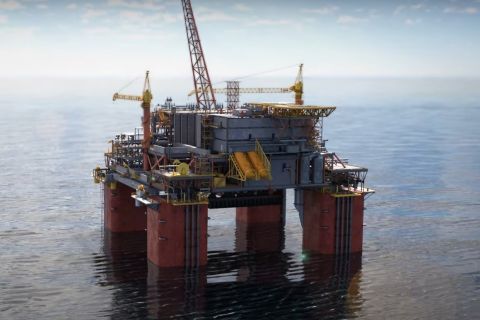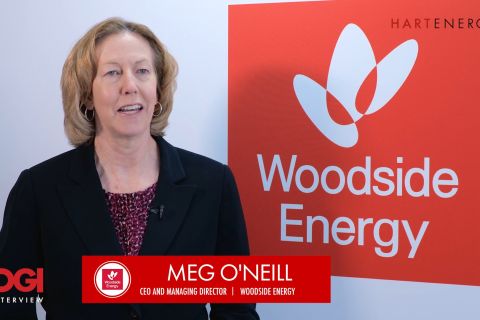
Almost a footnote at the end of a recent press release by Netherlands major Royal Dutch Shell, “upstream” was relegated to the end of the line of future growth-oriented investments with a mere two sentences of attention. (Source: Shell logo by Tonktiti / Shutterstock.com)
Presented by:

[Editor's note: A version of this story appears in the March 2021 issue of Oil and Gas Investor magazine. Subscribe to the magazine here.]
The Netherlands major Royal Dutch Shell Plc is the latest European international oil company to reveal its new strategy to pivot its long-term plan toward many things “green” and away from other things “fossil.” The goal: to be a net-zero emissions energy business by 2050.
“Our accelerated strategy will drive down carbon emissions and will deliver value for our shareholders, our customers and wider society,” Shell CEO Ben van Beurden said in a statement in early February.
“We must give our customers the products and services they want and need—products that have the lowest environmental impact. At the same time, we will use our established strengths to build on our competitive portfolio as we make the transition to be a net-zero emissions business in step with society.”
It’s a fine goal on the surface, lowering atmospheric greenhouse-gas emissions. In doing so, the company defined three business pillars for its redefined purpose. Hydrocarbons, notably, aren’t included in Shell’s go-forward “growth” strategy, not even in its “transition” strategy. Instead, the portfolio it was built upon is in the “funding our strategy” strategy. Oil and gas is the cash cow to fund the new vision. The new growth strategy: marketing, power, hydrogen and biofuels.
Almost a footnote at the end of a press release describing the details of future growth-oriented investments (electric vehicle charge points, sugarcane biofuels, distribution of clean-electron power, hydrogen distribution hubs), “upstream” was relegated to the end of the line with a mere two sentences of attention.
Regarding its massive global upstream portfolio in those two sentences, Shell said heretofore it would focus on value over volume, “being simpler and more resilient, continuing to provide material cash flow into the 2030s.” Additionally, investors can expect a gradual reduction in oil production “of around 1%-2% each year, including divestments and natural decline.”
Buried in a bulleted list, Shell “confirms that its total oil production peaked in 2019.” The not-so-subtle message: oil is a fading star on RDS’ energy stage.
RELATED:
Shell Executives Quit amid Discord over Green Push
Shell joins fellow Euro majors BP Plc and Total SA in messaging—and capitalizing to the tune of $5 billion to $6 billion annually—huge green energy business redirections. By their urgent actions, you would think these majors wholeheartedly believe oil and gas demand is fading to zero fast. But is it?
Quantum Energy Partners CEO Wil VanLoh is also a believer in the climate change imperative—“Climate change is happening; it’s real”—but he’s also an ardent believer in the critical role oil and gas plays—and will play—in meeting the world’s energy needs.
Speaking at IPAA’s virtual Private Capital Conference, VanLoh, contrary to the Euro major narrative, stated, “Do I think hydrocarbons have a future? I think they have an incredibly bright future.”
He pointed to a 2018 Energy Information Administration study that showed 80%-plus of global energy in 2035 will still come from natural gas, crude and coal—despite the push for non-fossil fuels. “It’s still a lot of energy for a long time that’s going to come from hydrocarbons,” he said.
The cost to try to meet this challenge in terms of renewable investment is really nothing short of extraordinary, he said. Some $6 trillion in renewable investment will be needed in North America through 2035 to supplant hydrocarbons. “That’s $600 billion a year,” he said. “When was the last time the U.S. oil and gas industry spent anywhere close to that drilling and completing wells?”
Globally, $80 trillion will be needed in three decades to meet the needs of renewable generation, he said. “You get a sense of the enormity of the challenge. When you look at the facts and figures, it’s a much bigger challenge than anyone would care to really admit,” he said.
“I’m optimistic because I know how big of a challenge we’re going to have transforming to a renewable energy sector and how much we’re going to have to invest in order to just maintain our productive capacity. It’s still a tremendous amount of hydrocarbons we’ve got to find in the next 15 years.”
When an Arctic blast put the Deep South into the deep freeze in mid-February, rendering millions of households without power, the crisis illustrated how much we depend on every energy source possible for our basic comforts and economies. Every single source of energy that the state of Texas relies upon for power generation was compromised by the freezing rains, according to the governor—nuclear, coal, wind, solar and, yes, natural gas. Don’t blame darkened solar panels and wind turbine freeze ups until you solve hydrate freeze offs at the wellhead that in part curtailed some 18 MW of generation.
Maybe the Euro majors are just ashamed to be seen with the hydrocarbs, but we’re going to need all forms of energy for decades to come. Or someone’s going to be in the dark.
Recommended Reading
Technip Energies Wins Marsa LNG Contract
2024-04-22 - Technip Energies contract, which will will cover the EPC of a natural gas liquefaction train for TotalEnergies, is valued between $532 million and $1.1 billion.
BP: Gimi FLNG Vessel Arrival Marks GTA Project Milestone
2024-02-15 - The BP-operated Greater Tortue Ahmeyim project on the Mauritania and Senegal maritime border is expected to produce 2.3 million tonnes per annum during it’s initial phase.
Deepwater Roundup 2024: Offshore Australasia, Surrounding Areas
2024-04-09 - Projects in Australia and Asia are progressing in part two of Hart Energy's 2024 Deepwater Roundup. Deepwater projects in Vietnam and Australia look to yield high reserves, while a project offshore Malaysia looks to will be developed by an solar panel powered FPSO.
Tech Trends: Halliburton’s Carbon Capturing Cement Solution
2024-02-20 - Halliburton’s new CorrosaLock cement solution provides chemical resistance to CO2 and minimizes the impact of cyclic loading on the cement barrier.
The OGInterview: How do Woodside's Growth Projects Fit into its Portfolio?
2024-04-01 - Woodside Energy CEO Meg O'Neill discusses the company's current growth projects across the globe and the impact they will have on the company's future with Hart Energy's Pietro Pitts.





